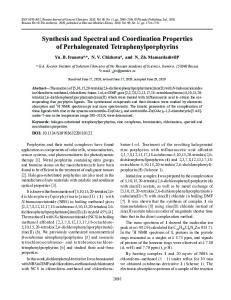Synthesis, crystal structures and magnetic properties of three porous coordination polymers based on a semirigid tripoda
- PDF / 2,578,240 Bytes
- 9 Pages / 595.276 x 790.866 pts Page_size
- 91 Downloads / 874 Views
Synthesis, crystal structures and magnetic properties of three porous coordination polymers based on a semirigid tripodal carboxylate ligand Yanchun Sun1 · Mingdong Yin1 · Shiqiang Chen1 · Jianshe Zhao2 Received: 4 August 2020 / Accepted: 20 October 2020 © Springer Nature Switzerland AG 2020
Abstract Three new coordination polymers, namely, {[Cu2(bcpmba)(μ4-OH)]·2H2O}n (1), [Mn(Hbcpmba)]n (2), and [Co2(bcpmba) (μ3-OH)·H2O]n (3) (H3bcpmba = 3,5-bi(4-carboxy-phenylene-methylene-oxy)-benzoic acid) have been prepared under solvothermal conditions. The complexes were characterized by physico-chemical and spectroscopic methods. All of the compounds 1–3 contain one-dimensional (1D) chains extended via the bcpmba3− bridge to generate 2D porous layers which are further connected by b cpmba3− ligands to form 3D porous coordination polymers. The result shows configurations of the ligand have an important influence on the structure. Magnetic susceptibility measurements indicate that compounds 1–3 exhibit antiferromagnetic coupling between adjacent metal ions, with the corresponding J value of − 2.76 cm−1 for compound 2.
Introduction The design and construction of the porous coordination polymers (PCPs) are extremely attractive, due to their potential applications in gas storage, separation, heterogeneous catalysis, and magnetism [1, 2]. Organic linkers and metal centers are of vital importance in the design and synthesis of porous coordination polymers with the expected structure and properties [3]. Among a large variety of organic building blocks utilized for constructing new PCPs and related compounds, aromatic multicarboxylic acids represent a particularly promising class of ligands owing to their high coordination versatility, different levels of deprotonation, thermal stability, and suitability for hydrothermal synthesis [4–8]. Electronic supplementary material The online version of this article (https://doi.org/10.1007/s11243-020-00433-5) contains supplementary material, which is available to authorized users. * Yanchun Sun [email protected] 1
School of Chemistry and Environmental Engineering, Sichuan University of Science and Engineering, Zigong 64300, Sichuan, People’s Republic of China
Key Laboratory of Synthetic and Natural Functional Molecule Chemistry of Ministry of Education, Shaanxi Key Laboratory of Physical‑Inorganic Chemistry, College of Chemistry and Materials, Northwest University, Xi’an 710069, People’s Republic of China
2
The semirigid aromatic multicarboxylate ligands are still good candidates for building PCPs on account of their rich coordination modes and various conformations [9, 10]. In the process of building PCPs, the semirigid aromatic multicarboxylate ligands can relatively easily regulate its configurations to enhance the structural diversity, in contrast to the rigid ligands with difficult conformational changes [11, 12]. Based on the above-mentioned considerations, a semirigid tripodal carboxylate ligand, H 3bcpmba (Scheme 1), was selected to synthesize coordinatio
Data Loading...











